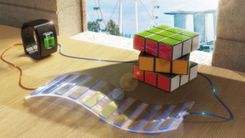Energy harvesting using shadows


The world of energy harvesting is on the up and up. In keeping with the recent trend of innovative technologies that harvest ambient energy from unassuming sources, scientists from the National University of Singapore have pioneered a new device that harvests energy from shadows!
Energy harvesting is having its day in the sun. Recently, there has been a spate of new energy harvesting technologies. Today, we are able to harvest energy from a long list of uncanny sources, including rust, wood and thin air! Sustainable methods of power generation are attracting enormous amounts of interest. We might not be very close to figuring out how to meet our gross energy demands but we are definitely making rapid strides when it comes to cracking sustainable, green-energy for wearables, sensors, and other small IoT devices.
The rise in popularity of energy harvesting technologies is thanks, in most part, to the mass-proliferation of IoT devices. We are fast moving towards an uber-connected world where all manner of everyday things are connected to the internet.
IoT devices come in all shapes and sizes. They can be deployed in remote outdoor locations or even inside a human body. It follows then that these IoT edge-devices would be better served by an autonomous power source. Batteries are just not a viable option to power billions of edge devices. In this article, we speak at length about why energy harvesting is, hands down, the best power solution for IoT devices. Moreover, batteries are environmentally expensive and are not a sustainable solution by any means.
Shadow power
In keeping with this trend, researchers from the National University of Singapore have developed a device called a shadow-effect energy generator (SEG), which opens the door to new possibilities in sustainable energy generation.
One of the leading issues with using solar cells as an energy source is that it is not reliable. While solar cells are great at harvesting energy in sunny, outdoor environments, their usefulness becomes questionable in indoor settings.
This project, led by Dr.Tan See Chwing, aims to solve this very problem. The shadow effect generator (SEG) harvests electricity by using the contrast between well-illuminated areas and shadows. This low-cost device is easy to manufacture and essentially performs two major functions: it converts illumination contrast into electricity while also acting as a proximity sensor to monitor nearby objects.
Dr.Tan See Chwing, who is an assistant professor in the materials science and engineering department at NUS commented, “Shadows are omnipresent, and we often take them for granted. In conventional photovoltaic or optoelectronic applications where a steady source of light is used to power devices, the presence of shadows is undesirable, since it degrades the performance of devices. In this work, we capitalized on the illumination contrast caused by shadows as an indirect source of power.”
He goes on to add "In this work, we capitalised on the illumination contrast caused by shadows as an indirect source of power. The contrast in illumination induces a voltage difference between the shadow and illuminated sections, resulting in an electric current. This novel concept of harvesting energy in the presence of shadows is unprecedented."
The team’s findings indicate that this prototype is twice as efficient compared to conventional solar cells, in conditions where there is a contrast between shadow and light.
How does it work?
The SEG has a really simple design - it uses a set of SEG cells that are arranged together on a transparent and flexible plastic film. Each SEG cell is a thin strip of gold film that is layered on top of a silicon wafer.
The SEG has been designed meticulously, in a bid to keep costs as low as possible. In fact, the team claims that the SEG can be made more cheaply than commercially available silicon solar cells.
When the SEG cell is placed in complete illumination or in the shade, it does not generate any significant amount of power. However, when it is placed in partial illumination, it generates a notable electrical output. The tests performed by the research team seemed to indicate that the ideal surface area for the device to generate electricity is when one half of the cell is lit and the other half is in the shade.
The team also conducted a few experiments to study the performance of the SEG both as a generator and as a self-powered sensor. They found that the energy harvested from the SEG device was sufficient to power a wearable device like a watch indoors, in the presence of shadows.
The SEG is also capable of working as a self-powered sensor for monitoring objects in motion. When something moves past the device, it casts a temporary shadow which activates the sensor and triggers it to record the presence of the object and capture its movement.
Wide range of potential functions
The team is set to conduct further experiments on the device, in a bid to optimise its functionality and reduce costs further. To this end, they are experimenting with materials other than gold.
Self-powered sensors tend to come with a wide range of possible functions. The research team is presently working on incorporating Wearable SEGs into apparel and accessories, in order to harvest power during day to day activities. The sky's truly the limit for what applications self-powered sensors can have - these sensors can be incorporated into various everyday objects to serve different purposes.
"With its cost-efficiency, simplicity, and stability, our SEG offers a promising architecture to generate green energy from ambient conditions to power electronics, and as a part of a smart sensor system, especially in buildings," add the researchers in their paper, which can be accessed here.













